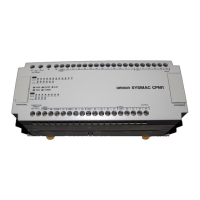156
Basic Procedure Section 4-1
4-1 Basic Procedure
There are several basic steps involved in writing a program. Sheets that can
be copied to aid in programming are provided in Appendix E I/O Assignment
Sheet and Appendix F Program Coding Sheet.
1,2,3... 1. Obtain a list of all I/O devices and the I/O points that have been assigned
to them and prepare a table that shows the I/O bit allocated to each I/O de-
vice.
2. If you are using LR bits to link two PCs, prepare sheet showing the used of
these bits.
3. Determine what words are available for work bits and prepare a table in
which you can allocate these as you use them.
4. Also prepare tables of TC numbers and jump numbers so that you can al-
locate these as you use them. Remember, the function of a TC number can
be defined only once within the program; jump numbers 01 through 99 can
be used only once each. (TC number are described in 5-15 Timer and
Counter Instructions; jump numbers are described later in this section.)
5. Draw the ladder diagram.
6. Input the program into the CPU Unit. When using the Programming Con-
sole, this will involve converting the program to mnemonic form.
7. Check the program for syntax errors and correct these.
8. Execute the program to check for execution errors and correct these.
9. After the entire Control System has been installed and is ready for use, ex-
ecute the program and fine tune it if required.
The basics of ladder-diagram programming and conversion to mnemonic
code are described in 4-3 Basic Ladder Diagrams. Preparing for and inputting
the program via the Programming Console are described in the CQM1 Opera-
tion Manual, CPM1 Operation Manual, the CPM1A Operation Manual and the
SRM1 Master Control Units Manual and via the SSS in the SSS Operation
Manual: C-series PCs.
The rest of SECTION 4 covers more advanced programming, programming
precautions, and program execution. All special application instructions are
covered in SECTION 5 Instruction Set. Debugging is described in the CQM1
Operation Manual, CPM1 Operation Manual, the CPM1A Operation Manual,
the SRM1 Master Control Units Manual, and SSS Operation Manual: C-series
PCs. SECTION 8 Troubleshooting also provides information required for
debugging.
4-2 Instruction Terminology
There are basically two types of instructions used in ladder-diagram program-
ming: instructions that correspond to the conditions on the ladder diagram and
are used in instruction form only when converting a program to mnemonic
code and instructions that are used on the right side of the ladder diagram
and are executed according to the conditions on the instruction lines leading
to them.
Most instructions have at least one or more operands associated with them.
Operands indicate or provide the data on which an instruction is to be per-
formed. These are sometimes input as the actual numeric values, but are usu-
ally the addresses of data area words or bits that contain the data to be used.
For instance, a MOVE instruction that has IR 000 designated as the source
operand will move the contents of IR 000 to some other location. The other

